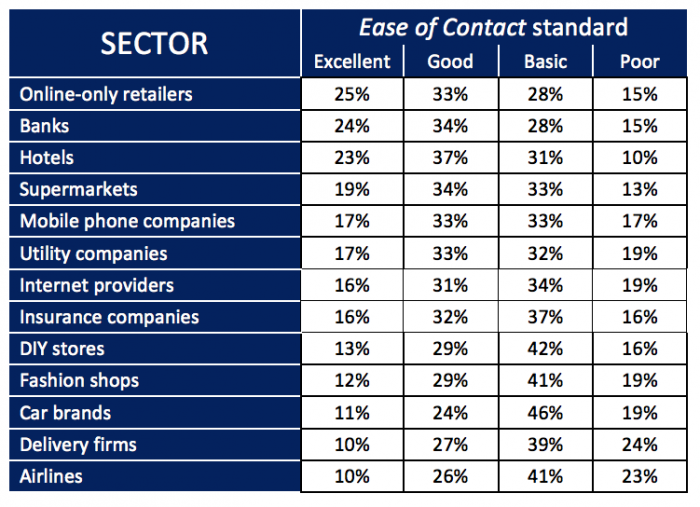Research shows that more than half of consumers stop buying after a poor customer service interaction and that 95% ‘share’ bad experiences – so what, if anything, are companies doing to stop customers ‘falling through the cracks’ in the multichannel experience brands are offering? And how can they improve that offering? Chris Robinson says they should start by looking to their lines of communication and ensuring their customers can easily reach them.
In today’s connected world, something surprising is happening. Despite our always on, always available society, British businesses are failing to provide customers with ways to keep in touch, and the majority of sectors are falling short.

The research commissioned by Yonder Digital Group canvassed 1,000 UK consumers, asking whether they felt that companies in a range of sectors were easy to get in touch with and efficient at getting queries resolved rapidly and effectively. Here is the table of results.
Airlines and delivery services are the worst culprits, according to the findings of research commissioned by Yonder Digital Group and surveying 2,000 UK consumers on the performance of a wide range of consumer-facing sectors. It asked whether they felt that companies were easy to get in touch with and efficient at getting queries resolved rapidly and effectively, and the answer was all too often ‘no’.
Asking how they would rate companies’ ease of contact, it found that no more than a quarter of people rated any one of the sectors as excellent, with the majority voted basic or poor by more than half.
How the sectors compare
Even so, some fared much better than others: online retailers with no bricks and mortar presence scored highest, for example, but still only 25% rate their contactability as excellent. Retail banking was voted the second most effective, with 24% giving banks the highest rating in this area. Hotels follow with 22.5% and, in fact, they received the lowest ‘poor’ score at just 9.6% with their scores polarised around ‘good’ at 37%. Supermarkets also did quite well with the second lowest ‘poor’ score, 13.1%, and an ‘excellent’ score of 19.2%.
In comparison, airlines and delivery services were only rated as excellent by 10%, with almost a quarter rating them both as poor, and the majority as simply basic. In fact, delivery firms have the worst poor score – from nearly a quarter of people (24.3%).
While car brands join airlines and delivery services to make up the bottom three, fashion and DIY stores don’t perform much better. The majority of consumers voted their ease of contact as basic (40.7% for fashion shops and 42.3% for DIY stores) with excellent scores of just slightly above 12%.
Falling roughly in the middle are mobile phone companies, utilities, internet providers and insurance companies. The majority of people scored these sectors as good or basic in terms of ease of contact, but utility companies, internet providers and mobile providers see quite high poor scores of 18.7%, 18.6% and 16.9% respectively, despite the fact that the latter two are ideally placed to leverage numerous contact points.
This is bad news for consumers and businesses alike. With UK online sales reaching £133bn in 2016, up £18bn on 2015, and ever-growing competition within sectors for customer share, retailers cannot afford to downplay the role of contactability in keeping customers loyal. Figures show that customer service really matters: according to an Accenture report, 52% of UK consumers have switched companies due to poor customer service, costing the UK more than £2bn a year, yet 73% of switchers said better customer service would have impacted their decision.
Multiple sectors, multiple issues
So what is going wrong and how can it be addressed? Reasons vary from sector to sector. Looking at a selection of them, Yonder’s research shows the DIY sector, for example, is not making its staff accessible enough, scoring very low on contactability and fast, effective problem resolution, despite the fact that people often need help getting to grips with DIY products once they have got them home.
It also shows that UK consumers find delivery firms the most difficult type of company to get in contact with when something goes wrong with their order: particularly frustrating when consumers find themselves caught up in the limbo between the retailer they purchased from and the delivery company. Clearly, delivery firms need to work harder to provide consumers with the fast, reliable issue resolution they require as well as giving easy ways to get in touch across a range of channels.
Another low scorer, airlines have a great deal of potential issues to deal with, including unexpected strikes and natural events that may drive up consumer queries and complaints unpredictably. There is also room for improvement in the banking sector with figures from the Institute for Customer Service providing a clear indicator of just how big a role good service plays in customer satisfaction and retention in this sector. It found that the five banks (Halifax, Nationwide, Santander, The Co-operative Bank and TSB) with higher than average customer satisfaction in July 2016 achieved an average of 16,510 net current account gains while those with lower than average customer satisfaction suffered an average net loss of 10,654 current accounts.
With utilities, a 2017 survey by Which? shows that many of the big players in particular score poorly for customer service and complaints handling. And, although widely present on social media, Yonder’s research suggests that fashion brands are also failing to carry out two-way conversations and are not making themselves easy to contact.
Brands should open up lines of communication
With previous research by Yonder also showing that customers will take their business elsewhere if their queries are not answered quickly and effectively by a company, it is clearly an issue that many companies across all sectors need to address.
The first step for any business is, of course, to ensure that customers can find their contact details easily and preferably offer a range of options to get in touch. This is critical to ensuring that queries are resolved efficiently but also relies on 24/7 multichannel support being provided with live agent interaction, be it by phone or live chat at key times of the day and night.
Identifying when these times are can be quite easily accomplished through an analysis of the customer journey, looking at the channels used, potential sticking points and where people most seek help, or indeed, abandon a purchase or enquiry. Having this support in place and being more responsive and efficient in answering queries is central to improving customer service and therefore satisfaction.
While some sectors perform better than others, clearly businesses across each and every one need to up their game. With figures showing that more than half of consumers stop buying after a poor customer service interaction and that 95% share bad experiences, there is no place for complacency. In our always-connected world, consumers are becoming increasingly accustomed to – and expectant of – swift query response across multiple channels, which means businesses that fail to meet these demands are very likely to lose their customers to those that do.
Have an opinion on this article? Please join in the discussion: the GMA is a community of data driven marketers and YOUR opinion counts.






Leave your thoughts